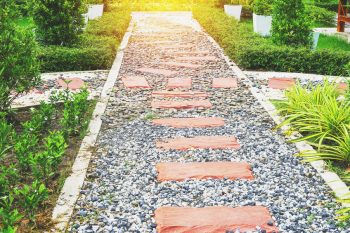
We Texans really do love our land. Even in metropolitan regions like the D/FW metroplex, we appreciate having the space to cultivate beautiful yards and verdant gardens. However, there’s been some talk in recent years about how sustainable an expanse of luscious lawn actually is.
For those who are dedicated to maintaining a carpet of comfy ground cover, be assured that we’ve got you covered. JC’s Landscaping remains loyal in our endeavors to provide quality broad-spectrum lawn care service year-round.
But if you’re looking to upgrade your landscape with newer trends that are both low-maintenance and eco-friendly, then hardscaping is the way to go. This method staves off weed growth, adds texture and personality to your yard, and requires absolutely no watering.
So what is a “hardscape,” anyhow?
This term refers to the use of ground cover materials that aren’t actually growing. It would be inaccurate to use the term “inorganic,” as some materials used in hardscaping are actually plant-based, such as bark, mulch and wood chips. But there are so many other forms we also want to introduce you to.
Click here to read more about the many benefits of creating hardscapes in your yard!
Common Hardscaping Materials
Let’s begin with the organic materials mentioned a moment ago. Because they will eventually begin to break down beneath the weight of weather and other natural processes, they won’t last as long as rock-based materials. And yet, they still offer an attractive, low-maintenance alternative to sustaining a vast expanse of grass.
If you plan to use plant-based materials for hardscaping, you’ll want to plan ahead to replenish them from one season to the next. But again, these are viable, low-cost alternatives to turf that will maintain a natural appearance in your lawn.
Organic Materials for Hardscaping
 Mulch
Mulch
Generally speaking, mulch includes any sort of wood-based ground cover. It’s great for protecting trees and shrubs from frost, especially considering that it will nourish your soil and surrounding plants as it begins to decompose. But it also makes a nice cover anywhere you aren’t growing grass.
Bark
Bark can be cultivated from your own yard if you’ve got mature trees that need their trunks pruned as the cooler weather sets in. However, this may not be an adequate supply to create ground cover for a significant area in your lawn. Check with your local garden store and lumber yard for inexpensive bark to buy in large quantities.
Wood Chips
Again, you’ll want to look first to your own yard before making unnecessary purchases. Do you have trees and bushes that need trimming, which will then supply a large portion of dried wood? Take advantage of that before visiting the lumber yard. Wood chippers can be rented from your local garden shop.
Inorganic Materials for Hardscaping
Most inorganic hardscaping projects include the use of rock-based materials. However, before we explore those, you should know there are a couple of exceptions worth considering. Mulch, stepping stones, and paving stones are all available in rubber, which can be far friendlier to the feet of your pets and loved ones. Get more information about, can I put pavers over grass?
Now let’s explore the rest of your inorganic hardscaping options, including the difference between stepping stones and paving stones:
Stepping Stones
These are what you think of when you imagine old-fashioned stone walkways running through a garden. They’re often spaced several inches apart, but they don’t have to be. Stepping stones are available in rubber, concrete, concrete and stone mixes, as well as other attractive varieties found at your home and garden shop. They are a perfect way to break up or section out your landscape while reducing the amount of grass and foliage to care for.
Paving Stones
Like stepping stones, these are a useful, low-maintenance aesthetic addition to your landscape. The difference is that paving stones are designed to cover a larger area, such as an entire deck or patio. Paving stones come in a broad variety of shapes, sizes, colors, and materials, making it easy for you to custom-fit them into your established landscape.
Flagstones
Flagstones are included in the realm of stepping stones and paving stones, though their use is a bit more versatile. For instance, they include the types of stones one would use to create a vertical barrier at the edge of a garden. Additionally, they can accent the edges of a stone deck, or be used for an entire expanse of ground cover. They’re typically pre-shaped in tessallating shapes that fit against each other naturally.
Gravel
This is likely the cheapest and simplest alternative to traditional landscaping. If it sounds drab and unattractive, consider placing a few large succulents in the area, such as yucca, cacti, or mature aloe vera plants. You can even add in a sprinkle of landscaping rocks to level up the color scheme..
Bricks
Ahh, the humble brick. Don’t overlook the aesthetic and functionality this class architectural staple has to offer when it comes to outdoor landscaping. Available in an array of colors and sizes, a groundwork laid with bricks can be rustically attractive and quite useful- anywhere from deck flooring to a well-placed front yard accent piece.
 River Rocks
River Rocks
Rocks of all sorts create a lovely, rugged ambience in any yard. You may actually be surprised at the array of options you’ll find at your local quarry or garden shop. They literally come in nearly every color imaginable, and they’ll provide an earthy “pop” to your landscape, laid adjacent to a garden spot and a well-placed stone pathway. River rocks are a favorite of ours, as the tumbled edges provide a softer appearance.
Boulders
Speaking of rocks, boulders are a beautiful addition to any landscape. Whether you’re going for a rugged terrain or a more manicured facade, an assembly of large and attractive stones can effectively accent your lawn. Though they’re a bit more difficult to come by- and to transport- than smaller rocks, the right placement can bring your yard’s aesthetic to the next level.
Conclusion
No matter which materials you use, hardscaping is a great, low-maintenance alternative to traditional landscaping. The organic materials we’ve mentioned will need to be replaced seasonally, but they’ll still be far simpler and cost-efficient as DIY methods to keep your lawn looking lovely. And the inorganic materials will last you for years to come. So get out there, get creative, and save on time, water, and other irreplaceable resources!

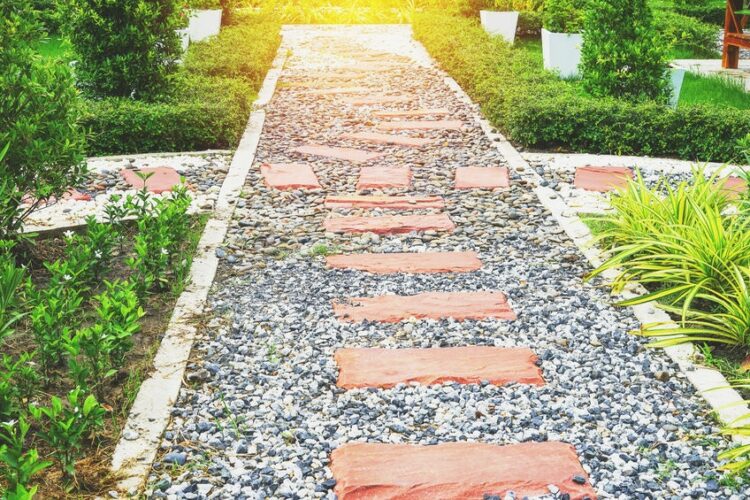
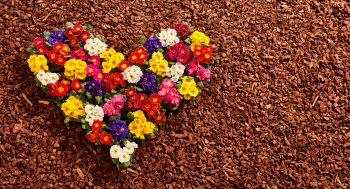 Mulch
Mulch River Rocks
River Rocks
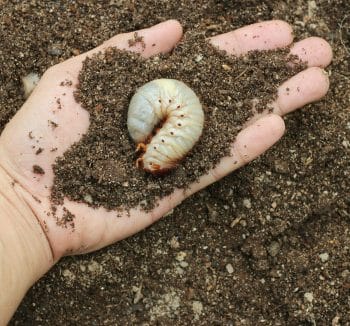
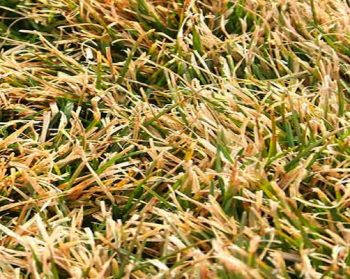
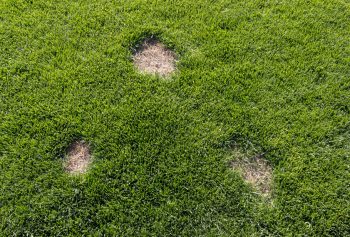
3 Responses
It’s good to know that river rocks come in different colors and can provide pop to the landscape. We’re trying to find more rocks for our backyard around our garden this month. I’ll be sure to find a place that supplies river rocks that will look good with our landscape.
Your idea of using paving stones as a material for a deck, since they come in various shapes and colors, is a great idea. My uncle wants to improve the appearance of his lawn but he’s not sure where to begin. I’ll share this with him so that he’d consider hiring a hardscaping expert for more advice.
We use these inorganic materials for Hardscaping. Some of our clients love the patterns and style that we are able to create. Due to the fact that it is a cost-effective option, it adds value to their property.